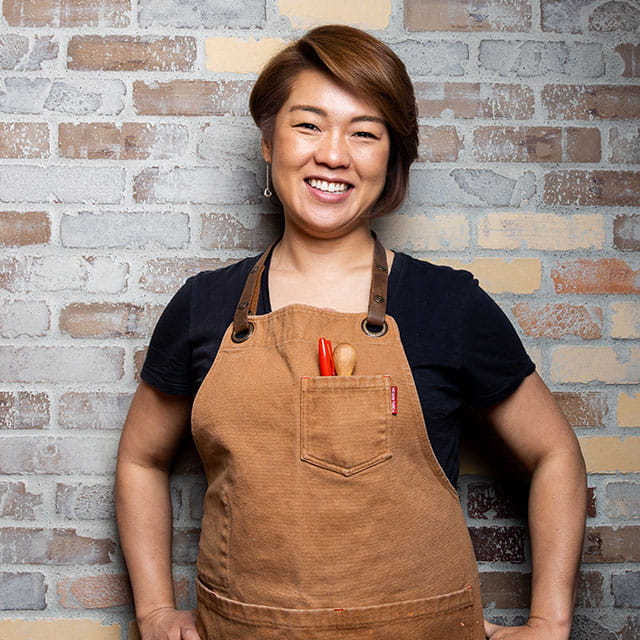
Chef Jinhee Lee
We stopped by Jin Bar to hear more of her incredible journey towards becoming Calgary’s Korean comfort go-to. View Culinary Connections for more.
Read BioBorn in Seattle, WA and starting his culinary journey at an acclaimed sushi restaurant at the age of 16, Chef Shota Nakajima soon set off to Osaka Japan to further understand the art of Japanese cuisine.
Fresh from his training under Michelin-accredited master Chef Sakamoto, Chef Shota returned to the United States to bring this award-winning trainer’s approach to food and hospitality to his own restaurant, Adana. Since this successful return to the American culinary scene, Chef Shota has been accredited with his own titles including a James Beard Award semifinalist nomination.
We recently spoke to Chef Shota about his own approach to Japanese cuisine and finding the balances between cuisine style, flavour and technique.
At Adana, your Japanese cuisine is offered as a comfort food with a fine dining point of view. Can you explain this concept further, including the inspiration behind it?
The inspiration comes from where I grew up and my culture. Half of my life I grew up in the United States and the other half in Japan. My mom cooked all the time and afterwards, from 18 to 23, I was training at a fine dining Michelin Star restaurant in Japan, mixing both of those cultures together.
Coming back to the States, I slowly began to understand the food that I like, which is the food that I grew up on that my mom made. I used those inspirations, incorporating the techniques that I had learned in Japan to develop my signature cooking style.
Which Japanese technique learned would you say contributes most to your concept?
That would be making dashi stock. I prepare dashi stock in a very proper way which is the bringing of kombu to 60-70 degrees but not over 70 degrees until you get the kombu flavour out. Sometimes this takes an hour, sometimes it takes 30 minutes. It's all about understanding the flavour profile.
Describe your flavour process for finding a balance between not only your fine dining and comfort food offerings but also your Japanese heritage.
At the end of the day, it's about what tastes good and what feels comfortable. If I taste a dish and it's something I would eat on a regular basis that’s what I am looking for in my dishes as a chef.
For example, our cedar smoked black cod. We use a good quality fish which we butcher, clean and cure. The curing process is one of the most important parts and we cure this with kombu salt. It's a combination of salt and kombu kelp which is reduced down and blitzed together in-house. This helps pull the umami and excess moisture out. We then marinade it in sake for about an hour, take it out and dry it skin-side up overnight so that the flavour rounds out and cures together. It's then grilled over charcoal.
Share with us how you alter your cooking techniques to elevate both your fine dining and comfort food-inspired dishes.
Some techniques are used across the board for everything. Cutting is one example. When I'm cutting ingredients, I have to make sure I'm not damaging the fibres by always having a sharpened knife.
Describe the role spices and seasonings influence the authentic Japanese flavour profiles of your dishes. Provide examples.
Japanese cooking is very simple, it's about dashi, soy, marinades and sake for the most part and balancing umami with sweetness, savoury and saltiness. For example, if you're cooking potatoes, it's going to be a 10-1-1 ratio. Your 10 is dashi, which is an empty flavour so it's the umami. Next is the mirin and soy which is your saltiness (1) and sweetness (1). You can balance that first 1 (saltiness) with .7 soy and .3 salt. For your (sweetness) 1, you can consider doing .3 mirin and .7 sugar or honey. All of this will create the ultimate flavour.
How do your multi-course tastings change with the seasons? Do you make special changes for holidays like Mother’s Day?
Our multi-course tasting menu changes almost every day, sometimes even in the middle of service. Some mornings, I'll go shopping and buy certain amounts of particular ingredients and we might run out because I don't buy a bunch at once. It's what I feel like and we'll incorporate what looks good at the time while also basing it off seasonality.
Which new flavours and ingredients can we expect to see making their way to the centre-of-the-plate in the near future?
Right now, we’re focusing on what’s available. In having a late spring this year, we're starting to get fava beans in, so that’s exciting. We’re also looking for but waiting on fiddleheads.
Eggplants are available and are coming out very delicious. Black cod is good right now as well because the water is still cold, so they stay nice and fatty.
Any advice or guidance for aspiring or up-and-coming chefs?
I have this non-belief in recipes as I personally don't believe in using them. I know that's kind of weird. Recipes make for a great base but depending on the ingredients, seasoning and temperature, everything changes per day. Make sure you always remember that and don’t go blindly through each dish. Always taste what you're making and add more salt, curry, OLD BAY, whatever you want if it’s needed. If you're using less of anything, adjust the rest.
Learn more about Chef Shota Nakajima.